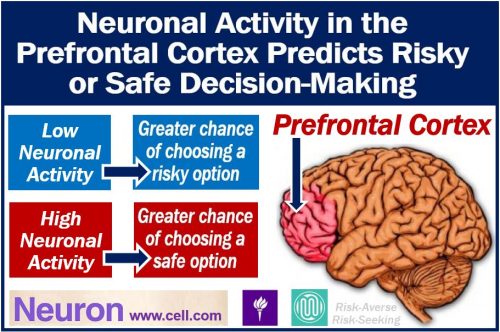By observing neuronal activity in the brain’s prefrontal cortex, we can predict whether rats will take a risky or safe decision. If neuronal activity is low, a rat will take a risk at the next opportunity. If, on the other hand, neuronal activity rises dramatically, that rat, the next time around, will take the safe option.
This is what scientists from the New York University School of Medicine and the Medical University (MedUni) of Vienna found. They wrote about their study and findings in the journal Neuron (citation below).
In an animal model, the researchers offered rats two choices:
- The safe option – which led to a small and reliable portion of food.
- The risky option – which led to either no food at all or a portion of food that was four times the size.
With the risky option, the scientists changed the rats’ probability of finding nothing or food several times during the experiment. The animals subsequently learned to adapt their risk appetite and strategy accordingly.

Scientists observed neuronal activity
The authors found that neuronal activity in the rats’ prefrontal cortex allowed them to make predictions. Specifically, predictions regarding which option – risky or safe – each rat would choose next.
They could predict by observing neuronal activity even if the rats made unexpected decisions in contradiction with previous experiences.
Co-author, Johannes Passecker, said:
“Based on the analysis of the neuronal activity, we were able to predict what decisions the test animals were going to make next.”
“Furthermore, through selective manipulation of the brain activity, we were even able to influence the decisions of the animals such that they took a higher risk with their gambles.”
Dr. Passecker, who was at the MedUni Vienna during the study, now works at Columbia University in New York.
The researchers had artificially introduced optogenetic proteins into the neurons of the prefrontal cortex of the rats’ brains. With laser light, it is possible to activate these proteins. Optogenetics is a biological technique involving the use of light to control cells in living organisms.
When the researchers selectively suppressed neuronal activity within the prefrontal cortex, the rats took the risky option. They took the risky option even if they had experienced sustained failure.
New treatment options for gambling or depression?
The scientists now want to identify those synaptic neural pathways and special cell types precisely. Specifically, those that are key to changing or sustaining people’s behavior.
The researchers want a better understanding of how such decision signals develop in the brain. They also want to know how different brain areas assemble the various aspects that are relevant to decision-making.
With a better understanding, they believe it could be possible one day to provide more effective treatments for people with illnesses such as depression and gambling addiction.
According to Dr. Passecker, with depression, it stands to reason that there is too little neuronal inactivity. Many patients with depression find it extremely hard to move out of their current state of mind. Sometimes, even getting out of bed becomes a major challenge that some find insurmountable.
Dr. Passecker added:
“With a gambling addiction, the neuron activity in the prefrontal cortex is also very low. Sufferers persist with the same pattern and are no longer capable of correctly assessing the risk of massive gambling losses, and accordingly changing over to the ‘safe’ option.”
Risk-seeking and risk-averse individuals
The terms risk-seeking and risk-averse are common in the world of markets, finance, and investment.
A risk-seeking individual loves risky investments. Risk-averse people, on the other hand, hate risks. They tend to purchase safe investments.
It would be interesting to monitor neuronal activities in the prefrontal cortex of risk-seeking and risk-averse people.
Citation
“Activity of Prefrontal Neurons Predict Future Choices during Gambling,” Johannes Passecker, Gordon Fishell, Nace Mikus, Hugo Malagon-Vina, Georg Dorffner, Philip Anner, Thomas Klausberger Jordane Dimidschstein, and Georg Dorffner. Neuron. Published: December 6, 2018. DOI: https://doi.org/10.1016/j.neuron.2018.10.050.

